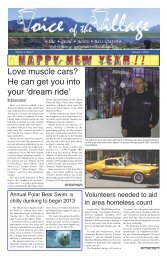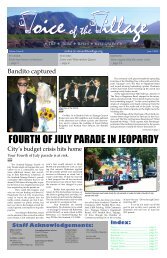STNC Election Time Again - Voice of the Village
STNC Election Time Again - Voice of the Village
STNC Election Time Again - Voice of the Village
Create successful ePaper yourself
Turn your PDF publications into a flip-book with our unique Google optimized e-Paper software.
10 | <strong>Voice</strong> <strong>of</strong> <strong>the</strong> <strong>Village</strong><br />
The Rowley family<br />
Cecile Page Vargo<br />
Bright brochures and colorful posters promising<br />
government land and a new life, combined with<br />
cheap and easy travel to get to <strong>the</strong>re, called to <strong>the</strong><br />
Rowley boys <strong>of</strong> Minnesota.<br />
Loron Rowley purchased a Sou<strong>the</strong>rn Pacific<br />
ticket and joined two bro<strong>the</strong>rs on <strong>the</strong> way to<br />
Sou<strong>the</strong>rn California, settling in Mandeville Canyon<br />
(Hollywood Hills), raising bees and selling honey. In<br />
1882, he ventured fur<strong>the</strong>r north to <strong>the</strong> foothills <strong>of</strong> <strong>the</strong><br />
towering San Gabriel Mountains. With <strong>the</strong> help <strong>of</strong><br />
<strong>the</strong> Verdugo family <strong>of</strong> California’s colorful Spanish<br />
Rancho period, Rowley was able to build his own<br />
ranch house on 160 homesteaded acres in what is<br />
now known as Seven Hills. Rowley and his family<br />
were amongst <strong>the</strong> first pioneers in Monte Vista<br />
Valley, which would grow up to be <strong>the</strong> communities<br />
<strong>of</strong> Sunland-Tujunga.<br />
In addition to <strong>the</strong> beehives that were brought up<br />
by buckboard through washes and logging roads,<br />
Rowley raised cattle and marketed <strong>the</strong> wood on his<br />
property. The ever-growing City <strong>of</strong> <strong>the</strong> Angeles some<br />
15 miles away needed <strong>the</strong> wood for steam boilers,<br />
heat and cooking. An abundant supply <strong>of</strong> greasewood<br />
and pine trees provided a lucrative business.<br />
In 1885, Rowley signed on to help build a twostory<br />
structure on <strong>the</strong> southwest corner <strong>of</strong> Central<br />
Avenue and First Street (now Fenwick and Oro Vista).<br />
The building was used for mail distribution and a<br />
general store that sold everything from crackers to<br />
Dave Kluge<br />
Among <strong>the</strong> notables from whom I learned about<br />
purposes is Thomas Jefferson. He gave us <strong>the</strong><br />
purpose <strong>of</strong> all governments in <strong>the</strong> Declaration <strong>of</strong><br />
Independence, in which he states that all men are<br />
created equal and that governments are created to<br />
ensure life, liberty and <strong>the</strong> pursuit <strong>of</strong> happiness for<br />
all citizens.<br />
Nice, huh? The Preamble to our Constitution<br />
gives us <strong>the</strong> purpose <strong>of</strong> our government. This is<br />
to establish justice, ensure domestic tranquility<br />
(calmness in our country), provide for <strong>the</strong> common<br />
defense, promote <strong>the</strong> general welfare (prosperity<br />
and happiness), and secure <strong>the</strong> blessings <strong>of</strong> liberty to<br />
ourselves and our posterity (our children and <strong>the</strong>ir<br />
children).<br />
Even nicer! Our Bill <strong>of</strong> Rights takes it a step<br />
fur<strong>the</strong>r. In 1789, <strong>the</strong> first Congress <strong>of</strong> <strong>the</strong> United<br />
States sent <strong>the</strong> Bill <strong>of</strong> Rights along with a Preamble<br />
to <strong>the</strong> state legislatures for <strong>the</strong>ir ratification. The<br />
Preamble simply stated that <strong>the</strong> Bill <strong>of</strong> Rights was<br />
being proposed to prevent <strong>the</strong> Constitution from<br />
being misconstrued or its powers abused, to broaden<br />
public confidence in our government, and to ensure<br />
<strong>the</strong> beneficial purposes <strong>of</strong> our government. These<br />
purposes tell us where we are supposed to be going as<br />
a nation and as a people. In my mind, <strong>the</strong>se purposes<br />
give us a yardstick by which we can judge how well<br />
we are doing as a country. Are we moving forward<br />
toward <strong>the</strong> stated purposes? Are we moving quickly<br />
or slowly toward our purposes? Are we backsliding<br />
away from our purposes? These are questions we<br />
should all consider and answer for ourselves. Our<br />
Constitution gives us <strong>the</strong> framework within which<br />
we can all achieve our purposes. It is <strong>the</strong> rules <strong>of</strong> <strong>the</strong><br />
game for being an American. (Dave Kluge, author <strong>of</strong><br />
The Peoples Guide to <strong>the</strong> Constitution, may be contacted<br />
at: dkluge@adelphia.net)<br />
kerosene. Rowley’s freight and mail service helped<br />
connect <strong>the</strong> early Sunland-Tujunga pioneers to <strong>the</strong><br />
outside world and made available to <strong>the</strong>m supplies<br />
<strong>the</strong>y could not raise or hunt <strong>the</strong>mselves.<br />
The great boom that brought Rowley and his<br />
bro<strong>the</strong>rs to Monte Vista Valley began to collapse in<br />
1888. Many original land and building prospectors<br />
moved and went on to o<strong>the</strong>r ventures. Rowley’s<br />
businesses and services suffered, too. By <strong>the</strong> 1890s,<br />
<strong>the</strong> wood played out and <strong>the</strong> forests were in need<br />
<strong>of</strong> replenishing. Rowley struggled with his cattle and<br />
beehives until <strong>the</strong> land developers and promoters<br />
arrived.<br />
During this time Rowley met his future wife, who<br />
came to tame a rowdy and struggling schoolhouse.<br />
Following a two-year courtship, Rowley and Virginia<br />
Florence Newcombe married.<br />
The year was 1893, and <strong>the</strong> ranch against <strong>the</strong><br />
hills became <strong>the</strong> new Mrs. Rowley’s home. Virginia<br />
Rowley continued to teach at <strong>the</strong> now orderly<br />
schoolhouse, as well as tend to her home garden and<br />
help with her husband’s various enterprises. The<br />
family grew with <strong>the</strong> birth <strong>of</strong> <strong>the</strong>ir first son Eustace<br />
in 1896.<br />
The family took up residence in <strong>the</strong> faded Monte<br />
Vista Hotel, bought by Loron Rowley’s bro<strong>the</strong>r Dr.<br />
Quentin Rowley. Two more children were born<br />
while <strong>the</strong>y lived and watched over <strong>the</strong> hotel. In 1893<br />
Purpose Local historian<br />
Jackie Houchin<br />
If you’ve ever visited Cecile Vargo in her warm,<br />
homey Yellow Cottage in Sunland, been served<br />
a mug <strong>of</strong> her fresh-brewed flavored c<strong>of</strong>fee, and<br />
munched on a few <strong>of</strong> her homemade oatmeal-raisin<br />
cookies, you’re not likely to forget <strong>the</strong> experience.<br />
From <strong>the</strong> moment I entered <strong>the</strong> quirky little<br />
house I was charmed. Beginning in <strong>the</strong> nook-<strong>of</strong>a-kitchen<br />
with sky blue, cabin-style cupboards,<br />
<strong>the</strong>n meandering through dog-legged halls and<br />
rooms chock full <strong>of</strong> quaint knickknacks, quilts <strong>of</strong><br />
all colors (on <strong>the</strong> beds, <strong>the</strong> walls, across chairs), and<br />
plump s<strong>of</strong>as and chairs you could sink into and be<br />
contentedly lost in for a day, I felt like I’d stepped<br />
back into an earlier, simpler time.<br />
Yellow Cottage is <strong>the</strong> perfect hideaway for a<br />
historian. Even before Vargo could walk, her family<br />
went on camping trips to <strong>the</strong> nearby mountains<br />
and national parks. She got her first look at <strong>the</strong><br />
ghost town at Calico when she was nine. Fifteen<br />
years later she, her husband and <strong>the</strong>ir young son<br />
started going on family vacations around Bishop,<br />
first staying in motels, <strong>the</strong>n a friend’s cabin, and<br />
finally graduating into a tent. The next step was<br />
a four-wheel-drive Chevy Blazer, but after a hard<br />
lesson on big mud puddles <strong>the</strong> couple took classes<br />
at Glendale College titled “Harry Llewellyn and<br />
Ecological 4-Wheeling Adventures.” The class<br />
included an <strong>of</strong>f-road trip that Vargo thought wasn’t<br />
much different from her own family outings, “…<br />
when we dug up history and found out where it<br />
was.”<br />
Soon <strong>the</strong> Vargos were hosting <strong>the</strong>ir own actionpacked<br />
journeys into <strong>the</strong> unpaved backcountry<br />
through Mojave, Bishop, Mammoth, Lone Pine<br />
and into Nevada, seeing <strong>the</strong> ghost towns <strong>of</strong> Bodie<br />
and Cerro Gordo. For nearly 20 years <strong>the</strong>y ran <strong>the</strong><br />
tours until <strong>the</strong> economy slowed and <strong>the</strong> liability<br />
insurance got too steep.<br />
After each trip Vargo would return home<br />
and write stories about <strong>the</strong>ir adventures. She<br />
called <strong>the</strong>m “trip-a-logues” and e-mailed <strong>the</strong>m<br />
Quentin Rowley sold <strong>the</strong> Monte Vista Hotel and <strong>the</strong><br />
family moved back to <strong>the</strong> ranch house against <strong>the</strong><br />
hills. The boys, Eustace and Robert, attended school<br />
- with a two-mile hike over rugged land to get <strong>the</strong>re.<br />
By 1905 Loron Rowley built <strong>the</strong> first rock home in<br />
Monte Vista on Hill Avenue near Flower Street (near<br />
today’s Hillrose and Floralita).<br />
Not only was it easier for <strong>the</strong> children to get to<br />
school, <strong>the</strong>y were also closer to community businesses<br />
and Loron Rowley’s endeavors beyond ranching and<br />
farming. Virginia Rowley moved her flock <strong>of</strong> chickens<br />
and her vegetable garden to <strong>the</strong> backyard behind <strong>the</strong><br />
stone house. An adjacent pasture was perfect for <strong>the</strong><br />
family horses and milk cows. A running spring kept<br />
<strong>the</strong> ground damp and <strong>the</strong> grass green year-round.<br />
Two more children would be born here.<br />
At an early age <strong>the</strong> Rowley children pitched<br />
in where needed, at home or one <strong>of</strong> <strong>the</strong> family<br />
businesses. Loron and Virginia Rowley made sure<br />
<strong>the</strong>y were well-schooled and received formal music<br />
lessons. The children were seen in <strong>the</strong> evenings on<br />
<strong>the</strong> big front porch, playing games and practicing<br />
<strong>the</strong>ir musical instruments. Weekends were large<br />
homegrown dinners, with Sundays reserved for<br />
church activities. The Rowley family had a large<br />
presence in <strong>the</strong> Foothill community and was well<br />
known.<br />
To be continued.<br />
to friends. Later she started posting her stories<br />
on desert-focused online message boards. Finally<br />
she developed her own Web site.“This became my<br />
passion, being out in nature, exploring ghost towns<br />
and writing. I want to travel <strong>the</strong> backcountry and<br />
research and write for <strong>the</strong> rest <strong>of</strong> my life,” Vargo<br />
said.<br />
Vargo is researching ghost towns and local<br />
history and compiling it into a book which she<br />
hopes to publish soon.<br />
“I want to <strong>of</strong>ficially call myself a writer and a<br />
historian, instead <strong>of</strong> pretending,” she said.<br />
But certainly she is writer, historian and more<br />
already.<br />
(Read Vargo’s history <strong>of</strong> <strong>the</strong> Rowley House in this issue.<br />
Visit her Web site at http:// www.explorehistoricalif.com<br />
for more histories, personal accounts <strong>of</strong> living in ghost<br />
towns, and photos.)




